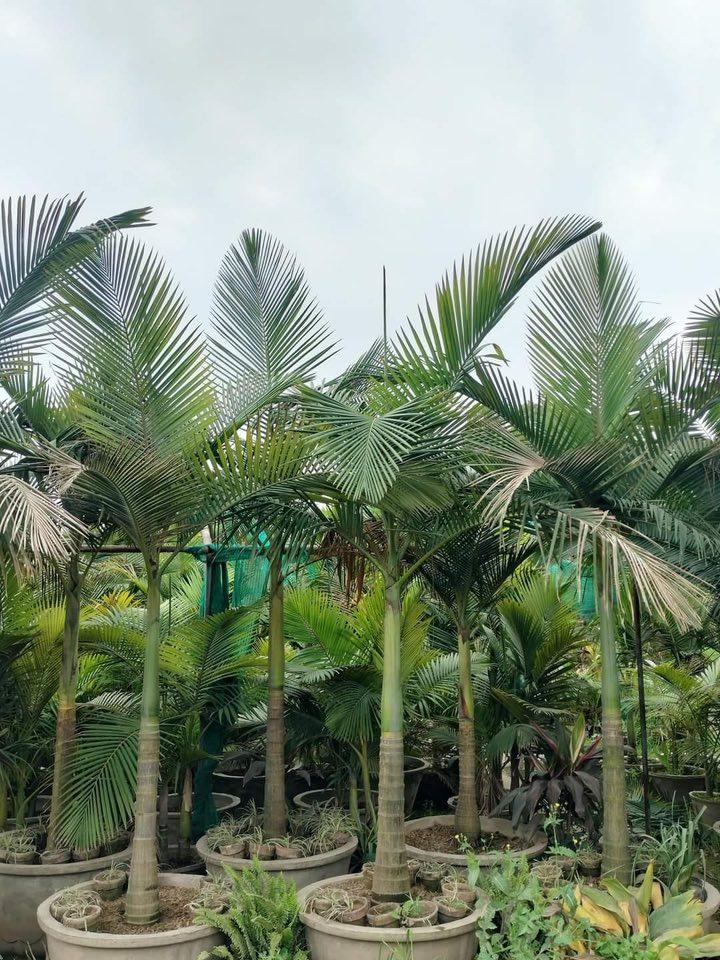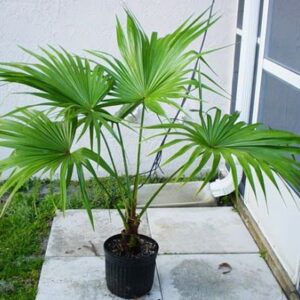Alexandra Palm “🌴✨The Graceful Royal of the Tropics
The Alexandra Palm, also known as the King Palm of Queensland or Alexander Palm, is a statuesque, self-cleaning palm tree native to northeastern Australia. With its tall, slender trunk, lush canopy of arching fronds, and elegant appearance, it’s a favorite for both tropical landscaping and large container gardening in warm regions.
🌿 General Description
Botanical name: Archontophoenix alexandrae
Common names: Alexandra Palm, King Palm, Alexander Palm, Northern Bangalow Palm
Type: Single-trunk, evergreen palm
Height: 20–40 feet in gardens; up to 80 feet in native habitat
Spread: 8–15 feet
Trunk: Smooth, grey with ringed scars, green crownshaft
Fronds: Pinnate (feather-shaped), arching up to 10–15 feet long
Flowers: Creamy white clusters under the crownshaft
Fruits: Bright red berries; attractive to birds
☀️ Light and Temperature Requirements
Sunlight:
Thrives in full sun to partial shade
Young palms appreciate partial shade; mature ones prefer full sun exposure
Temperature:
Optimal range: 20–35°C (68–95°F)
Tolerates brief drops to -2°C (28°F), but prefers frost-free areas
USDA Zones: 10–11
🌤️ Ideal for tropical to subtropical gardens. In cooler zones, it can be grown in a container and overwintered indoors.
💧 Watering Routine
Alexandra Palm prefers consistent moisture, especially during hot or dry spells.
Young palms:
Water 2–3 times per week
Established palms:
Water weekly, more often in dry or sandy soil
Avoid waterlogging—plant in well-drained areas
💦 Likes humid conditions but adapts to drier ones with regular watering. A mulch layer helps conserve moisture and cool the roots.
🌱 Soil and Fertilizer Requirements
Soil:
Well-drained, rich loamy or sandy soil
Tolerates a variety of soils but thrives best in slightly acidic to neutral pH (6.0–7.0)
Poor drainage can lead to root rot
Fertilizer:
Use a palm-specific fertilizer with micronutrients (e.g., magnesium, manganese) every 2–3 months in spring through fall
Avoid excess nitrogen; it may lead to fast but weak growth
🧪 Tip: A slow-release 8-2-12 fertilizer helps maintain lush, green fronds and prevent yellowing.
✂️ Pruning and Maintenance
Self-cleaning: Older fronds drop naturally as the palm grows, minimizing maintenance
Pruning:
Only remove dead or damaged fronds
Never cut green fronds or the crownshaft—it can harm the plant
Mulching: Use organic mulch around the base to retain moisture and suppress weeds
✂️ Avoid planting too close to buildings or walkways—falling fronds or fruits can cause mess or injury.
🌿 Propagation Methods
Seeds (primary method):
Fresh seeds germinate in 6–12 weeks
Soak seeds in warm water overnight to soften the outer coat
Plant in moist, warm, well-drained soil
Offsets/Pups:
Alexandra Palms do not produce offsets, unlike clustering palms
🌱 Patience is key—seedlings may take a few years to reach 3–4 feet.
🐛 Pests and Problems
Common pests:
Mealybugs
Scale insects
Red palm weevil (in some regions)
Diseases:
Ganoderma butt rot (a fatal fungal disease)
Leaf spot and root rot in poor drainage
🛡️ Prevent issues by:
Avoiding overwatering
Using neem oil or insecticidal soap for pests
Maintaining good airflow
⚠️ Yellowing fronds may indicate nutrient deficiency, especially potassium or magnesium.
🏝️ Landscape and Garden Use
Ideal for:
Tropical-themed gardens
Poolside or resort landscaping
Driveway accents
Large containers for patios or entrances
🌴 Often used in rows or as solitary centerpieces. Beautiful when underplanted with ferns, caladiums, bromeliads, or crotons.
✅ Conclusion
The Alexandra Palm is a graceful, fast-growing tropical palm that adds instant height and elegance to landscapes. With its feather-like fronds, self-cleaning habit, and low maintenance needs, it’s a favorite in warm gardens and urban spaces alike. Give it sun, water, and space to grow, and it will reward you with decades of lush beauty.
“





Reviews
There are no reviews yet.